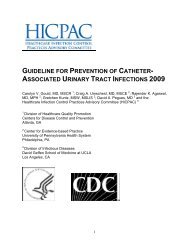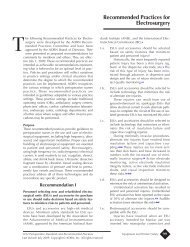Legal Issues in the Care of Pressure Ulcer Patients - Medline
Legal Issues in the Care of Pressure Ulcer Patients - Medline
Legal Issues in the Care of Pressure Ulcer Patients - Medline
Create successful ePaper yourself
Turn your PDF publications into a flip-book with our unique Google optimized e-Paper software.
sttttttttttttsIn written guidel<strong>in</strong>es, patient care plans, or any o<strong>the</strong>r documented expectations <strong>of</strong> care, avoid absolutewords such as “always,” “never,” “must,” “shall” or “immediately.” Ano<strong>the</strong>r example <strong>of</strong> an <strong>in</strong>correctlywritten statement might be, “Abnormal lab values must be reported immediately.” That means dropeveryth<strong>in</strong>g—<strong>in</strong>clud<strong>in</strong>g a life-threaten<strong>in</strong>g emergency—to report <strong>the</strong> abnormal values or <strong>the</strong> hospital hasfailed to meet its own standard <strong>of</strong> care. The literal mean<strong>in</strong>g <strong>of</strong> <strong>the</strong> words is what a pla<strong>in</strong>tiff’s lawyerwill advocate aga<strong>in</strong>st you when it is to <strong>the</strong> pla<strong>in</strong>tiff’s benefit to do so. And why not? You wrote <strong>the</strong>policy. You chose <strong>the</strong> words. Such statements should be written carefully to allow <strong>the</strong> rightful role<strong>of</strong> cl<strong>in</strong>ician judgment. A better way to phrase <strong>the</strong> example statement could be, “Report abnormal labvalues <strong>in</strong> a timely fashion.”2. Assess<strong>in</strong>g Compliance with Prescrib<strong>in</strong>g RulesKey Concept: Healthcare organizations and cl<strong>in</strong>icians should review stand<strong>in</strong>g orders to ensure that<strong>the</strong>y are <strong>in</strong> compliance with prescrib<strong>in</strong>g regulations.Institutional practices need to be evaluated to ensure that <strong>the</strong>y are <strong>in</strong> compliance with prescrib<strong>in</strong>gregulations. These should be rout<strong>in</strong>ely re-evaluated as well to ensure <strong>the</strong>y rema<strong>in</strong> <strong>in</strong> compliance withregulations, which change relatively <strong>of</strong>ten. For example, if a wound is debrided us<strong>in</strong>g an enzymaticdebrid<strong>in</strong>g agent, a healthcare provider with prescriptive privileges such as a physician, nurse practitioner,or physician’s assistant, must sign <strong>the</strong> order, s<strong>in</strong>ce such agents are pharmaceuticals.Some facilities may have evolved “stand<strong>in</strong>g orders,” <strong>in</strong>corporat<strong>in</strong>g enzymatic debrid<strong>in</strong>g agents, thatnurses can <strong>the</strong>n implement without a provider’s signature. However, such a practice would be out <strong>of</strong>compliance with prescrib<strong>in</strong>g laws.3. Chang<strong>in</strong>g and Practic<strong>in</strong>g With<strong>in</strong> Scope <strong>of</strong> PracticeKey Concept: Healthcare <strong>in</strong>stitutions should ensure that caregivers are practic<strong>in</strong>g with<strong>in</strong> <strong>the</strong>ir scope<strong>of</strong> practice with regard to pressure ulcer assessment and documentation.As part <strong>of</strong> new CMS policy, pressure ulcers will be assigned ICD-9 (International Statistical Classification<strong>of</strong> Diseases and Related Health Problems) diagnosis codes accord<strong>in</strong>g to <strong>the</strong>ir stage as well aslocation. Although pressure ulcer stag<strong>in</strong>g (which is a part <strong>of</strong> rout<strong>in</strong>e assessment and documentation) haslong been <strong>the</strong> purview <strong>of</strong> nurses, this bill<strong>in</strong>g policy change could have legal implications, s<strong>in</strong>ce onlyadvanced practitioners and o<strong>the</strong>r CMS-def<strong>in</strong>ed “providers” can make medical diagnoses. CMS def<strong>in</strong>esa provider as a physician or any qualified healthcare practitioner who is legally accountable forestablish<strong>in</strong>g <strong>the</strong> patient’s diagnosis. 12As a result, physicians now need to change <strong>the</strong>ir practice and <strong>in</strong>corporate pressure ulcer stag<strong>in</strong>g alongwith location <strong>in</strong>to <strong>the</strong>ir notes. Given <strong>the</strong> limited physician knowledge about pressure ulcers reported<strong>in</strong> <strong>the</strong> literature, 13 <strong>the</strong> need for educat<strong>in</strong>g physicians to acquire this competency is paramount.Cl<strong>in</strong>icians at <strong>the</strong> generalist level also need to understand that <strong>the</strong>y will be held accountable for do<strong>in</strong>ga basic sk<strong>in</strong> assessment and pressure ulcer risk assessment. For example, staff nurses might <strong>in</strong>correctlydelegate <strong>the</strong>se assessments to <strong>the</strong> wound care specialists ra<strong>the</strong>r than understand<strong>in</strong>g <strong>the</strong>ir responsibilityfor do<strong>in</strong>g <strong>the</strong>se assessments.stttttttttttts<strong>Legal</strong> <strong>Issues</strong> <strong>in</strong> <strong>the</strong> <strong>Care</strong> <strong>of</strong> <strong>Pressure</strong> <strong>Ulcer</strong>s: Key Concepts for Healthcare Providers6
















